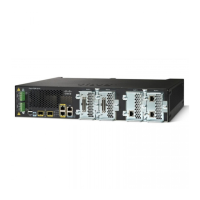16-14
Catalyst 3550 Multilayer Switch Software Configuration Guide
78-11194-09
Chapter 16 Configuring STP
Configuring Spanning-Tree Features
To return to the default setting, use the no spanning-tree mode global configuration command. To return
the port to its default setting, use the no spanning-tree link-type interface configuration command.
Disabling Spanning Tree
Spanning tree is enabled by default on VLAN 1 and on all newly created VLANs up to the spanning-tree
limit specified in the “Supported Spanning-Tree Instances” section on page 16-9. Disable spanning tree
only if you are sure there are no loops in the network topology.
Caution When spanning tree is disabled and loops are present in the topology, excessive traffic and indefinite
packet duplication can drastically reduce network performance.
Beginning in privileged EXEC mode, follow these steps to disable spanning tree on a per-VLAN basis.
This procedure is optional.
To re-enable spanning tree, use the spanning-tree vlan vlan-id global configuration command.
Configuring the Root Switch
The switch maintains a separate spanning-tree instance for each active VLAN configured on it. A bridge
ID, consisting of the switch priority and the switch MAC address, is associated with each instance. For
each VLAN, the switch with the lowest bridge ID becomes the root switch for that VLAN.
To configure a switch to become the root for the specified VLAN, use the spanning-tree vlan vlan-id
root global configuration command to modify the switch priority from the default value (32768) to a
significantly lower value. When you enter this command, the switch checks the switch priority of the
root switches for each VLAN. Because of the extended system ID support, the switch sets its own
priority for the specified VLAN to 24576 if this value will cause this switch to become the root for the
specified VLAN.
If any root switch for the specified VLAN has a switch priority lower than 24576, the switch sets its own
priority for the specified VLAN to 4096 less than the lowest switch priority. (4096 is the value of the
least-significant bit of a 4-bit switch priority value as shown in Table 16-1 on page 16-4.)
Note The spanning-tree vlan vlan-id root global configuration command fails if the value necessary to be the
root switch is less than 1.
Command Purpose
Step 1
configure terminal Enter global configuration mode.
Step 2
no spanning-tree vlan vlan-id Disable spanning tree on a per-VLAN basis.
For vlan-id, you can specify a single VLAN identified by VLAN ID
number, a range of VLANs separated by a hyphen, or a series of VLANs
separated by a comma. The range is 1 to 4094.
Step 3
end Return to privileged EXEC mode.
Step 4
show spanning-tree vlan vlan-id Verify your entries.
Step 5
copy running-config startup-config (Optional) Save your entries in the configuration file.

